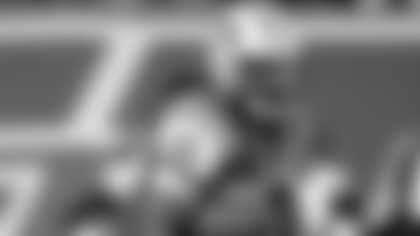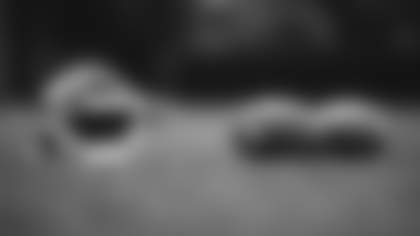
It doesn't take long to list all the defensive linemen that the Jets selected during the 12-round 1991 NFL Draft.
Mark Gunn and Paul Glonek.
Chosen in the fourth round, Gunn, from the University of Pittsburgh, would join Browning Nagle and Mo Lewis as the only draftees to make the team.
"The spotlight was kind of on me. Most of the veteran (defensive linemen) were looking at me like, 'You ain't going to take my spot.' Everybody was really quiet until they figured out, you know, I was an okay guy. That took a little while," Gunn laughed.
Playing in 15 games as a rookie mostly as a backup, Gunn made one start at left defensive end. He had hoped to contribute more by staying put.
"I was learning everything, but they kept moving me around. To be really good at anything, especially on the defensive line, you've got to stay in one spot," Gunn said. "When you switch from the left side to the right side, that's tough because now you've got to learn everything in reverse.
"I felt like that hurt me over time because instead of getting those reps in the same spot and getting better, I would get some reps in one spot, start to get the hang of it, and then they would switch me to another spot. I would have to learn it all over again.
"I resented that part of my experience in hindsight. When it was going on, I was young and just wanted to play. So I didn't really care. When I look back, it was kind of a gift and a curse. It was a gift because I could play those other positions. I think that was part of the reason why they were able to move me around. But I know that I had my most success when I was allowed to stay in one place."
Which occurred for several games the following season. After opening the year playing mostly at defensive tackle, Gunn would become the starter at left defensive end for four consecutive games, beginning in Week 5, after Dennis Byrd was sidelined because of a dislocated shoulder.
He'd become the starting defensive end again in Week 14, again replacing Byrd, who had suffered a career-ending neck injury in New York's previous game.
"I wasn't on the field (when Byrd and Scott Mersereau convened on Chiefs quarterback Dave Krieg in the backfield and collided, which caused Dennis to suffer immediate paralysis). But I was about to relieve him like a play before it happened," Gunn said. "Dennis had been in, and either he was getting tired or we were alternating, and (defensive line coach) Greg Robinson wanted me to spell him.
"It was real difficult. It scared all of us. I know it scared me, personally. I didn't question whether I wanted to play or not. I still wanted to play, but I started thinking about getting hurt. Which is not good. So it took me a little while to get over that. And as Dennis started to get better, I started to feel better about playing."
Through surgeries, rehabilitation, and his faith, Byrd eventually regained the ability to walk again. And he did so in front of the players, coaches, and 79,088 fans who were in MetLife Stadium on October 28, 2012, when the Jets retired his No. 90 during halftime of a game against Miami.
"I was glad to see it because we all loved Dennis and we wanted him to be okay," Gunn said. "He was a brother. So, yeah, for him to walk out on the field, that was a great feeling."
Sandwiched between two seasons and a handful of games with New Orleans and Philadelphia, Gunn spent four years with the Jets, 1991-93, '96.
And now making his home in San Antonio, Texas, Gunn, who has a daughter, Mahlya, is a cyber systems engineer for a software company, Alamo City Engineering Services (ACES).
"We do a lot of cybersecurity protection for government entities. Like the DOD, for example. We protect their networks," Gunn said. "And ACES is partnered with Forescout (Technologies), a cybersecurity protection company. Their software platform allows you to get visibility.
"Let's say you own a big company and you've got 100,000 employees. You've got some who use cell phones, laptops, desktops, tablets, printers, everything. All this stuff is connected to their network. So when it comes to vulnerabilities, there's all kinds of potential ways to penetrate the network through all those different peripherals.
"So what Forescout does, it enables you to be able to see everything that's on a network. Because a lot of times, these large companies, they have so many things connected to the network, they're not always able to see what's on it at any given time. You could get exploited.
"Forescout makes sure that you see everything that's connected. And it works in real time. So as soon as you plug something in, boom, right away, it lets the administrator know that something is there."
ACES has also developed new technology called containerization.
"When you normally send an email, it leaves a footprint. There's a record that I sent it on my end and on your end. You could delete the email, but it's still artifacts that will say that I sent you that email," Gunn said. "So what this software does is, let's take that same email, and before you would send it, you will put it inside this container.
"When you send that email, you can give it certain permissions. You can say you can read this email only. You can't edit it. You can't delete it. You can't forward it. You can't take a screenshot of it. You can't copy it. You can't do anything with it. The only thing you can do is look at it. You can even put a time limit on it to make it dissipate in a certain amount of time, like self-destruction. And you can revoke this email. When it's revoked, it takes all trace of artifact that a normal email will leave."
Gunn feels this technology can also benefit the Jets and other teams in the NFL.
"Think about coaches in the press box and how they communicate to the sideline," he said. "You see quarterbacks with tablets and stuff like this, they're sending plays, screen shots, all kinds of things wirelessly. What they don't know is, or what they probably all the way don't understand is, when that stuff is sent wirelessly, it really is vulnerable.
"So if you send plays, information, or whatnot, inside of a container from the press box to the sideline, it's completely airtight. No one can penetrate it under no circumstances unless you give them specific permission to."














